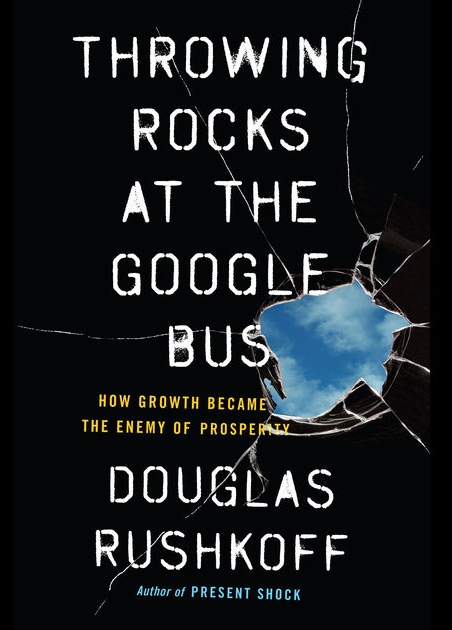Book Review: “Throwing Rocks at the Google Bus” by Douglas Rushkoff
David Rostcheck / Op Ed
Posted on: June 9, 2016 / Last Modified: June 9, 2016
 The economic effects of emerging disruptive technologies like Artificial Intelligence (AI) pose an area of deep thought and concern. AI represents a “winner-take-all” technology. Companies that invest in it can dominate their competitors, exacerbating a trend of wealth inequality that is already a growing concern. This change is playing out against a landscape of other shifting economic trends: tech companies increasingly being built to flip for quick profit, distributed technologies like the blockchain facilitating new types of corporate entities like the Distributed Autonomous Organization (DAO), and labor displacement raising calls for a “basic minimum income”.
The economic effects of emerging disruptive technologies like Artificial Intelligence (AI) pose an area of deep thought and concern. AI represents a “winner-take-all” technology. Companies that invest in it can dominate their competitors, exacerbating a trend of wealth inequality that is already a growing concern. This change is playing out against a landscape of other shifting economic trends: tech companies increasingly being built to flip for quick profit, distributed technologies like the blockchain facilitating new types of corporate entities like the Distributed Autonomous Organization (DAO), and labor displacement raising calls for a “basic minimum income”.
A new book by Douglas Rushkoff, “Throwing Rocks at the Google Bus,” digs deep into the architecture of the money system and corporate charters to get to the root of the inequality trend and ask how we can modify our institutions to cope with overwhelming automation-driven prosperity. In this review of Rushkoff’s book, I look at the social issues resulting from highly productive but unequally distributed technology and how the investment cycle of Silicon Valley startups has become captured by finance. I then follow Rushkoff as he delves into the historical origins of our money and corporate charter systems to see how the rules written into their code shape our world today, and discuss how some of the alternate structures he explores favor different economic evolution.
Book Review – Throwing Rocks at the Google Bus: How Growth Became the Enemy of Prosperity, by Douglas Rushkoff
Will this new round of AI-assisted technologies lead to massive job destruction? The question troubles many technologists, including myself. In Throwing Rocks at the Google Bus Douglas Rushkoff observes that technology has pushed our financial system to the limits of its architecture, and then digs into what that architecture is and how it could be changed to facilitate social stability.
The title comes from a protest against Google’s private San Francisco bus system, during which protesters threw rocks at the bus. Rushkoff began musing about who was the villain in the story: Was the protesters, who were being forced out of their city by gentrification? Was it the young tech workers on the bus, just trying to work a good job? Was it Google, a company that began with the altruistic stance of democratizing internet search away from Yahoo’s centrally-controlled corporate model? Was it Google’s CEO, pursuing a policy of relentless growth, or the shareholders that demanded that growth – our own retirement funds? Ultimately, Rushkoff concluded, all actors played out their roles in good faith, but the increasing centralization of power and money was built into the system itself. With that in mind, he turned attention to how our economic and corporate system is built and how it will deal with the challenges of new information technology.
Information technology is disruptive – and AI is even more disruptive
AI is both an inherently disruptive technology and a highly asymmetric one. AI is now good enough to displace humans from routine cognitive jobs, raising the specter of significant economic disruption. Advanced automation is rapidly displacing jobs from fast-food order-takers to truck drivers to investment managers. Further, AI is inherently asymmetrical. Businesses that lead in AI adoption – such as Google, Facebook, Amazon, and Uber – are disrupting many industries and dominating their competitors. Most businesses can now use AI in some way, but most are not doing so. Those that do so first enjoy an enormous first-mover advantage. Many, if not most, business leaders are unprepared for the changes that are not just coming, but here [note: If your strategy for handling advanced technology could be better, I can help; see my info below]. We can all see the inequality rising as a few advanced firms dominate the business landscape, growing in market capitalization while most recede.
“Too good at making stuff”
Rushkoff points out that AI simply follows a long series of technological innovations – IT, materials technology, industrialization – whose net effect has been to been to develop a society that can produce material abundance for its population with ever-decreasing labor. But our social system depends on almost everyone working – it is not designed to support abundance. We have ended up with capital and goods piling up in huge excess in some institutions, causing money velocity – and economic activity – to falter. Pooling of excess capital has become the defining problem of the new century, a problem that every central bank struggles with.
Growth as the enemy of prosperity
Rushkoff identifies the problem as a shift in focus from profit to growth – where growth means growth in number of users, eyeballs, employees, or anything but profits. The internet-age companies of the “new economy” are built around the central premise of growth at any cost, eschewing profit and instead intending to IPO or, more likely, sell out to another internet titan that needs to show more… growth. Once Wall Street accepted valuing profit-less companies on growth, the die was cast. Venture capital – once an esoteric subset of business investment – became the model for investment in general. And venture capital demands huge returns – 10x return on investment will not compensate for the risk; they need 100x or 1000x, so companies financed by venture capital must continually pivot into new territory, abandoning profitable business models in search of the hold grail: platform monopoly. Now startups are born, become unicorns, get acquired, and/or die quietly, going through an entire lifecycle without profit. In fact, they often desperately avoid profits, which would fix a real valuation to one that, in the absence of numbers, can be argued to be anything.
Seen in that context, recent articles by Silicon Valley VCs telling companies to get profitable instead of expecting additional rounds are a bitter joke. Those companies will never be profitable; they have been systematically designed to grow, by those very same VCs. The choice of growth over profit is fundamentally built into their DNA. Amazon has operated for decades without profit and is considered to be a success. Twitter, on the other hand, is considered to be in crisis because its growth has stalled. Google has been morphed from a technology company into Alphabet, a holding company for other technology companies, to better enable more growth. In a way this is an old game, the one established by finance: companies race to become “too big to fail” – a limit at which the surrounding society must find some way to support them, or absorb the social damage of their failure.
The ultimate game is monopoly, or quasi-monopoly. Having established near-monopolies in their markets, the titans pivot into new markets seeking unsustainable growth. Eventually they collide with each other: Walmart strip-mines economic activity from communities into its centralized system, arranging its labor to taking advantage of the indirect subsidies from the welfare system, only to then be disrupted by Amazon, whose heavily robotized warehouses can ship goods to clients through the subsidized postal system. Apple wants to build cars to take Tesla’s market. Google builds Android to take Apple’s market. Rushkoff points out that this “new economy” is simply an echo of the very old economics of monopolization. We saw it in the Gilded Age, when Standard Oil – the Google of its day – extended its tentacles into every business activity it could. But Rushkoff traces the pattern back even farther to colonial Europe, sending its armies forth to secure resources and monopolize trade in the newly opened markets of the developing world.
The Great Stagnation
But whereas the armies of workers in industrial age companies provided a means to pump money back into the system, information-age companies need very few workers. The money they capture in transactions pools up in a small labor pool, whose savings go into… equities from the same set of companies. And as any investment manager can tell you, the bigger the pool of assets you need to manage, the fewer investment choices you have. The money becomes stagnant, failing to circulate. Velocity of transactions drops.
The barons of Silicon Valley simply can’t push the money out into the economy effectively. When they do invest, they invest in what they know – a cycle of internet billionaires funding VC firms that fund scrappy startups (which must all be physically in San Francisco) designed to flip into acquisitions by internet companies. Main Street’s interaction with the cycle becomes one-way: contributing capital through pension funds, but rarely receiving commensurate economic benefit. The system becomes a pump that extracts savings from the real economy and pools them in Silicon Valley valuations. But this system does not circulate much money, and it does not support a large number of jobs. Economic activity falls, with no solution in sight.
Medieval origins of the money system and corporate charters
The problem of stagnant pooling of capital in Silicon Valley has become a defining problem for our age. Indeed, in San Francisco one hears an undercurrent of discussion about trying a “guaranteed basic income” – ultimately an attempt to restart the circulation of money by forcibly pumping it back toward the general public.
This discussion often becomes a criticism of market capitalism in general. But Rushkoff instead draws a finer line, noting that we have adopted a very specific encoding of market capitalism, intended to promote specific objectives at the expense of others, and that we can adopt a different one. And here he does something quite interesting, that I have seen no author do. Spurred by his thoughts about the Google bus protest and how the problem is inherent in the system itself, he traces the money system and corporate charters back to their origins in medieval Europe to identify why they were organized they way they are and what can be done to change them.
Rushkoff notes that both the debt-based money system and the modern chartered corporation came about as reactions by the European aristocracy to contain a surging peer-to-peer economy that was enriching the middle class. Spurred by new innovations brought from the East via the crusades, European villages adopted the bazaar (the centralized market), time-limited high-velocity local currencies, and other innovations that let them effectively transact with each other. Threatened by their relative loss of power, the aristocracy responded by imposing two structures designed to protect their power. First, they imposed a centralized (later debt-backed) state currency. Second, they enacted royal chartered monopolies on industries that required the king’s permission to engage in a business. Over five centuries those structures have evolved into debt-based state currency and the chartered corporation. In a debt-backed currency, money is loaned into circulation at an interest rate. This structure inherently requires growth to pay the interest, which a government simply directly printing money would not. The corporate charter generally requires a CEO to maximize shareholder return instead of, for example, nurturing an ecosystem of customers. Public corporations, which are evaluated on a quarterly basis, impose an even shorter-term view on return. But Rushkoff points out that we do not have to choose these structures – they are legacy code from centuries ago, still doing what they were programmed to do – centralize wealth – but at a digitally-enhanced speed and scale.
Solutions – from B-corporations to DAOs
At this point, Rushkoff turns to highlighting example solutions. Since the root of the stagnating economy problem is centered in a money system and a corporate charter that require growth, he explores solutions that are structured toward more sustainable ends. Some solutions, such as parallel local currencies, emphasize local transactions and increasing money velocity. Others, including crowdfunding solutions like Kickstarter, change the funding model to seeking direct funding from customers or community members rather than seeking risk capital from VCs.
As an alternative to centralized monopolistic systems, he advocates decentralized systems. His solutions range from the technologically simple – using B Corporations or nonprofits instead of VC-backed for-profit corporations to avoid the growth-at-all-costs focus – to the more complex (distributed autonomous organizations, or DAOs, organized on the blockchain). One solution he favors is creating worker-owned platforms – “platform cooperatives” – in which workers own a portion of the platform, so if they are replaced with automation they gain the income from their fractional ownership. An example he likes is La’Zooz, an Uber-competitor run on a decentralized blockchain-based system.
In general, Rushkoff’s solutions tend to be local, decentralized, sustainable, and community-based – whether that community is real or virtual. It is worth noting that changing the focus from growth requires an ongoing conversation about values. For example, although many universities are chartered non-profit institutions with education as their primary goal, it is obvious that, at least in the U.S., they do not act in alignment with those values. University tuition has risen exponentially – a clearly unsustainable trend – to the point where degrees now often do not provide net value to their recipients. Nonprofit charter notwithstanding, universities, which are coupled to the same addictive easy-money debt-based loan system, take in as much as they can get and spend it on expensive physical plant acquisitions and exploding administrative costs. Online learning such as Coursera and Udacity threaten to disrupt higher education to students’ benefit – but they are also VC-backed institutions taking in significant venture funding and seeking platform monopolies. Their present altruistic stance will be shaped by those constraints – as was Google’s.
Conclusion
“Throwing Rocks at the Google Bus” provides an insightful set of analytical tools we can use to look at the way institutions are structured and identify how they will evolve. I recommend it for technologists and others who are concerned about the economic disruption resulting from AI technologies and advanced automation.
About the Author:
 David Rostcheck is a consulting data scientist helping companies tackle challenging problems and develop advanced technology. He can be reached at drostcheck [at] leopardllc.com.
David Rostcheck is a consulting data scientist helping companies tackle challenging problems and develop advanced technology. He can be reached at drostcheck [at] leopardllc.com.








